AD Risk Gene Analysis (ARGA) Group (Kamino's group)
Member:Kouzin Kamino (Assistant Professor), Ryo Kimura (Graduate Student), Aidaralieva Nuripa (Graduate Student)
Familial early-onset AD is caused by mutations of presenilin 1 and amyloid protein precursor and unidentified genes. On the other hand, late-onset AD is thought as onset of polygenic diseases caused by the complex interactions among risk genes such as apolipoprotein E gene, environmental factors and aging. We are searching for AD-related genes through genome scanning, applying them to early diagnosis of AD, and also evaluating them as target molecules to therapeutic and preventive approach. These genes could be related to the development and maintenance of cognitive function, and genetic approach is expected to expand into the elucidation of memory mechanism.
γ secretase group (Okochi & Tagami's group)
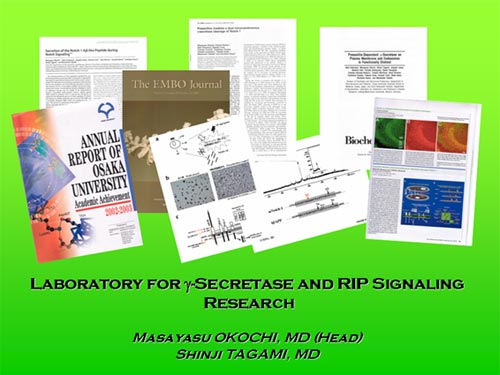
Tau group (Tanaka's group)
Members :Toshihisa Tanaka, M.D., Ph.D., Golam Sadik, Ph.D., Begum Nurun Nessa, M.D., Kiyoko Kato, M.S.
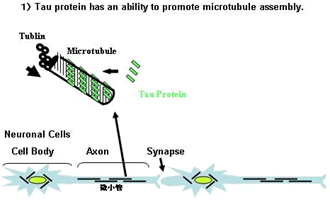
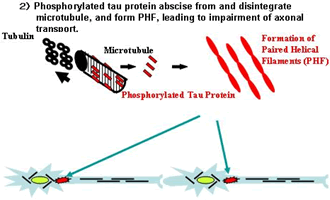
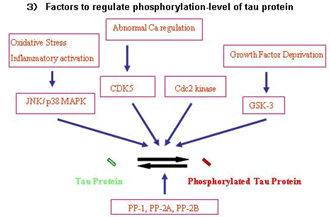
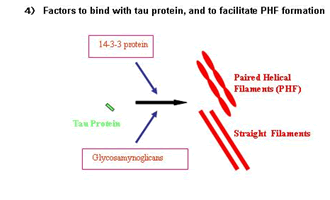
We have been investigating mechanisms of neurodegeneration with hyper-phosphorylation of tau protein Alzheimer disease (AD) and tauopathy (Psychogeriatrics 5; 15-17,2005.). A frame of cell are sported by microtubules, intermediate filaments and microfilaments. Tau protein plays a role as a hinge between tubulin-dimers, and promotes microtubule assembly (1). When tau protein is phosphorylated, it loses its binding activity with and disintegrate microtubule. Furthermore phosphorylated tau protein forms paired helical filaments (PHF) that leads to impairment of axonal flow resulting in cellular damages (2). Phosphorylation levels of tau protein is regulated by balance between several kinases and phosphatases (3). Kinases that phosphorylates tau protein, are so called praline-directed kinases including MAP kinases (JNK/ p38 MAPK), cyclin-dependent kinases (CDK5、cdc2 kinase), and glycogen synthase kinase-3 (GSK-3) (Annal.Psychiat. 5,65-79,1995.). We investigated the relation of activation of GSK-3 and phosphorylation of tau protein, and it was revealed that phosphorylation level of tau protein was regulated by a signal transduction pathway under insulin or IGF, through activity of GSK-3, and that this pathway was linked to apoptosis importantly (J. Neurochem. Exp. Neurol. 56,70-78.1997. FEBS Lett 469,111-117,2000. Acta Neuropathol (Berl) 105:381-92,2003.). On the other hand, phosphatase including PP-1, PP-2A, and PP-2B, are involved in dephosphorylation of tau protein. Theses phosphatases are also involved in regulation of activities of the above kinases, and we found inactivation of protein phosphatases induces hyper-phosphorylation of tau protein through direct and indirect ways (FEBS Lett. 426,248-254,1998.).
In AD inflammatory process are known to be involved, and we investigate an innate immune-system including Toll-like receptors (TLRs) that links to JNK/ p38 MAPK in AD brain. Actually JNK/ p38 MAPK locate in signal transduction pathway under some TLRs, and these kinases are activated by stimuli to TLRs (Psychiatry Clin Neurosci. ;60 Suppl 1:S27-S33, 2006.). In relation to apoptosis, involvement of apoptosis has been frequently reported, and execution of apoptosis is determined by balance of pro- and anti-apoptotic factors, therefore we have investigated involvement of anti-apoptotic factors in AD and repression of expression of anti-apoptotic factors by Amyloid beta (NeuroReport 15;851-854,2004.). In fact slowly progressive neuronal cell death observed in AD brain might be explained by these balances of pro- and anti-apoptotic factors.
Tau protein forms paired helical filaments (PHF) or straight filaments, and binding factors like glycosaminoglican and 14-3-3 promote self-assembly of tau protein (4). We found that binding of tau with 14-3-3 protein, a scaffold protein, was regulated by tau-phosphorylation, therefore we investigate the mechanisms in detail. From these studies we are going to figure out new aspects or novel functions of tau protein and we aim to reveal mechanisms of neurodegenerative diseases, based on tauopathy.
Bioinformatic group (Morihara's group)
Today, several drugs are available for Alzheimer's disease (AD) treatment and have shown suppression of disease progression, but none of them have a dramatic effect. In 1906, exactly 100 years ago, the first AD case was reported by Dr Alois Alzheimer. In 1970s reduction of choline acetyltransferase activity in AD was demonstrated. Choline esterase inhibitors which are clinically used today have been developed based on this observation. In these few decades, basic research strongly suggests that amyloid pathology is more specific and upstream of AD pathology than other pathology including the dysfunction of choline acetyltransferase activity. However, we don't have any drug which directly suppresses amyloid pathology in AD. Anti-amyloid drugs are under intensive development in many institute including mega pharmaceutical companies.
On the other hand, non-steroidal anti-inflammatory drugs (NSAID) have been suggested to protect onset of AD. Many epidemiological studies, with the exception of some, continuously showed the anti- AD effects by NSAID. Furthermore, we and others recently revealed that NSAID can suppress amyloid pathology in in vitro and in vivo studies. This unexpected effect of NSAID considerably influences the development of other AD drugs which aim to suppress amyloid pathology. Different kinds of anti-AD mechanism by NSAID have been revealed. We continue to study the anti-Alzheimer mechanisms of NSAID and curcumin.
Identification of the key molecules in AD is useful for developing new therapy and diagnosis tools. We are analyzing Alzheimer model mice using bioinformatic tools to reveal AD related genes.
Molecular Psychiatry Group (Hashimoto's group)
Ryota Hashimoto, M.D., Ph.D. (Assistant professor) hashimor@psy.med.osaka-u.ac.jp, Yuka Yasuda (Research resident), Sachie Chiba (Graduate student), Naomi Iike (research student).
This group studies molecular mechanisms of mental disorders such as schizophrenia, major depression, bipolar disorder and other mental disorders. We engaged in two main themes. One is clinical research to find the susceptibility genes for mental disorders; the other is basic research to investigate the function of susceptibility genes. In clinical research, we perform genetics, neurocognition, neuroimaging, neurophysiology and gene expression using human subjects. In basic research, we work on animal models of mental disorders such as pharmacological models (antipsychotics treatment and psychostimulant treatment), genetic models (knockout mice and transgenic mice for dysbindin, a susceptibility gene for schizophrenia) and environmental models (environmental enrichment and stress). Studies using cell biological methods are also conducted. Our research goal is to elucidate the pathophysiology of mental disorders by translational approach, which connects basic and clinical research.
The group which investigates neurodegeneration processes from the point of view of organelles (Kudo's group)
Takashi Kudo, M.D., Ph.D. (Associate professor) kudo@psy.med.osaka-u.ac.jp, Hitoshi Tanimukai, M.D., Ph.D., Ryo Kimura, M.D., Eiichiro Kamagata, M.D., Nobuhiko Tabuchi, Mikiko Kubo
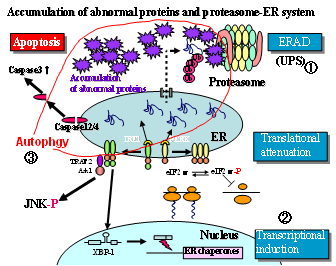 The common feature of neurodegenerative diseases including Alzheimer disease is the accumulation of aggregation-prone proteins in nerve cells. Therefore, investigating this process in detail may lead to a comprehensive cure for neurodegenerative disorders. Recently, the pathway through proteasome and processing by autophagy are regarded as major intracellular protein processing mechanisms. Because proteasome links with an endoplasmic reticulum functions, and endoplasmic reticulum stress responses also contributes to a degenerative process by accumulation of aberrant proteins. Therefore, we can go ahead through study from three viewpoints (See figure);
The common feature of neurodegenerative diseases including Alzheimer disease is the accumulation of aggregation-prone proteins in nerve cells. Therefore, investigating this process in detail may lead to a comprehensive cure for neurodegenerative disorders. Recently, the pathway through proteasome and processing by autophagy are regarded as major intracellular protein processing mechanisms. Because proteasome links with an endoplasmic reticulum functions, and endoplasmic reticulum stress responses also contributes to a degenerative process by accumulation of aberrant proteins. Therefore, we can go ahead through study from three viewpoints (See figure);
[1] Study to clarify the relations between accumulation of aberrant proteins and endoplasmic reticulum stress response(UPR; unfolded protein response).
[2] Study to clarify the relations between accumulation of aberrant proteins and proteasome functions.
[3] Study to clarify the relations between accumulation of aberrant proteins and autophagy.
The aim of all studies is a development of the therapy for neurodegeneration.
Our recent fruits are;
(1) Mutation of presenilin 1, representative responsible gene of familial Alzheimer disease, cause the vulnerability for endoplasmic reticulum stress(Nat Cell Biolog 8: 479-485, 1999 J Biol Chem 276: 43446-43454, 2001 Ann N Y Acad Sci 977: 349-355, 2002 Biochem Biophys Res Commun. 318: 435-438, 2004).
(2) The chaperone protein induced by endoplasmic reticulum stress changes metabolism of amyloid to amyloid production(Biochem Biophys Res Commun 344: 525-530, 2006).
(3) On the basis of these results, we already succeed in development of an endoplasmic reticulum chaperone inducer (patent pending) and begin examination about application to the treatment for neurodegenerative disorders.
